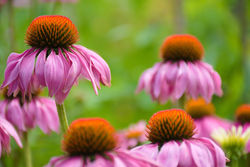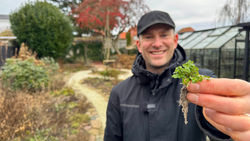Best perennial flowers for a wildflower meadow
- Lars Wildes
- Feb 10, 2023
- 5 min read
Updated: May 12, 2023
Want to bring a little bit of the great outdoors to your backyard? Then a wildflower meadow might just be the thing. Think of it as a mini-nature reserve right in your garden.
A wildflower meadow is like a beautiful painting come to life, with a variety of native and non-native plants painting the landscape with different colors and blooms throughout the year. Sounds gorgeous, right? It is.
And the best part? It's not just a pretty face. A wildflower meadow is a wildlife magnet, attracting all sorts of helpful pollinators like bees, butterflies, and birds.
The key to growing your own wildflower meadow is choosing perennials that come back every year and are tough enough to handle whatever Mother Nature throws their way. The ones here on my list don't need much fussing over, so you can sit back, relax, and enjoy the show.
And, since they're adapted to local conditions, they can thrive with minimal watering. If you're ready to bring sustainable, natural beauty to your backyard, field, or garden, then get ready to plant your very own wildflower meadow.
Colorful perennials for a wildflower meadow
The best part about the perennial flowers on this list is that they’re easy to start from seeds.
This is important because you’ll need to grow them from seeds first and then set the seedlings out in your wildflower meadow. This gives your plants a better chance of surviving against pioneer plants like weeds.
Yarrow (Achillea millefolium)

Height: 60-90 cm (24-35 in)
Spread: 30-45 cm (12-18 in)
Yarrow is a hardy and drought-tolerant wildflower that has clusters of white, yellow, or pink flowers that bloom in summer. The nectar-rich flowers are highly attractive to pollinators, including bees, butterflies, and other insects. This plant is also a good choice for a wildflower meadow because it is self-seeding and can spread, ensuring a continuous display of color in your garden.
Coneflower (Echinacea sp.)

Height: 60-90 cm (24-35 in)
Spread: 30-45 cm (12-18 in)
Coneflower is a popular wildflower that has large, daisy-like flowers in a range of colors, including pink, purple, orange, and yellow. The nectar-rich flowers are highly attractive to pollinators, including bees, butterflies, and other insects. Coneflower is also a good choice for a wildflower meadow because it is self-seeding and can spread, ensuring a continuous display of color in your garden.
Salvia (Salvia sp.)

Height: 60-90 cm (24-35 in)
Spread: 30-45 cm (12-18 in)
Salvia is a wildflower that has spikes of brightly colored flowers in shades of blue, purple, red, or pink. The nectar-rich flowers are highly attractive to pollinators, including bees, butterflies, and other insects. Salvia is also a good choice for a wildflower meadow because it is self-seeding and can spread, ensuring a continuous display of color in your garden.
Black-eyed Susan (Rudbeckia)

Height: 60-90 cm (24-36 inches)
Spread: 30-45 cm (12-18 inches)
This iconic wildflower produces yellow to orange daisy-like flowers with dark brown centers, attracting pollinators such as bees, butterflies, and hummingbirds. Black-eyed Susan is a hardy and easy-to-grow perennial that self-seeds readily, ensuring a continuous supply of new plants for your wildflower meadow.
Blazing Star (Liatris)

Height: 60-90 cm (24-36 inches)
Spread:30-45 cm (12-18 inches)
Blazing Star is a tall wildflower-meadow-perfect perennial with spikes of fluffy purple flowers. It blooms in late summer to early fall and attracts pollinators such as bees, butterflies, and hummingbirds. Blazing Star is a long-lasting perennial that self-seeds easily, providing a steady supply of new plants to your wildflower meadow.
Shasta Daisy (Leucanthemum x superbum)

Height: 60-90 cm (24-36 inches)
Spread: 30-45 cm (12-18 inches)
This classic wildflower produces white daisy-like flowers with yellow centers, attracting pollinators such as bees, butterflies, and ladybugs. Shasta Daisy is an easy-to-grow perennial that self-seeds readily, making it a great choice for your wildflower meadow.
Coreopsis

Height: 30-45 cm (12-18 inches) Spread: 30-45 cm (12-18 inches)
Coreopsis is a versatile wildflower that bursts with bright yellow, daisy-like flowers that bloom in summer and attract pollinators such as bees, butterflies, and ladybugs. Coreopsis is a low-maintenance perennial that self-seeds easily, making it a great choice for your wildflower meadow.
Wild Bergamot (Monarda fistulosa)

Height: 60-90 cm (24-36 inches)
Spread: 30-45 cm (12-18 inches)
Wild Bergamot (Bee Balm) produces pink, lavender, or purple spikes of flowers that bloom in summer, attracting pollinators such as bees, butterflies, and hummingbirds. Wild Bergamot is a long-lasting perennial that self-seeds easily, ensuring a continuous supply of new plants for your wildflower meadow.
Ironweed (Vernonia)

Height: 60-90 cm (24-36 inches)
Spread: 30-45 cm (12-18 inches)
This hardy wildflower produces spikes of purple flowers that bloom in late summer to early fall, attracting pollinators such as bees, butterflies, and moths. Ironweed is a robust perennial that self-seeds readily, providing a constant supply
Wild Blue Phlox (Phlox divaricata)

Height: 30-60 cm (12-24 in)
Spread: 30-45 cm (12-18 in)
This native wildflower has delicate blue or pink flowers that bloom in spring. The fragrant blooms are highly attractive to pollinators, including bees and butterflies. Wild Blue Phlox is an important source of nectar for early-season pollinators. This plant is also self-seeding, making it an excellent choice for a wildflower meadow as it can spread and establish itself with minimal effort.
Goldenrod (Solidago sp.)

Height: 60-150 cm (24-59 in)
Spread: 60-90 cm (24-35 in)
Goldenrod is a late-season bloomer, with bright yellow spikes of tiny flowers that attract many pollinators, including bees, butterflies, and beetles. Its nectar is an important source of food for many insects in the fall. This plant is also a good choice for wildflower meadows because it self-seeds and can spread over time, ensuring a continuous display of yellow flowers in your garden.
Milkweed (Asclepias sp.)

Height: 60-150 cm (24-59 in)
Spread: 60-90 cm (24-35 in)
Milkweed is an important plant for pollinators, especially Monarch butterflies, as it is one of the few plants that Monarchs will lay their eggs on and the only food source for Monarch caterpillars. This wildflower has clusters of pink, red, or orange flowers that bloom in summer. Milkweed is also a good choice for a wildflower meadow because it self-seeds and can spread, making it an important source of food and habitat for many pollinators in your garden.
Swamp Milkweed (Asclepias incarnata)

Height: 90-120 cm (35-47 in)
Spread: 60-90 cm (24-35 in)
Swamp Milkweed is a native wildflower that is similar to Milkweed but is better adapted to wet soils. This plant has clusters of pink, rose, or purplish flowers that bloom in summer. Like Milkweed, Swamp Milkweed is an important food source for pollinators, including Monarch butterflies. This plant is also a good choice for a wildflower meadow because it self-seeds and can spread, making it an important source of food and habitat for many pollinators in your garden.
How to plant and care for a wildflower meadow with perennials
While the meadow is relatively low maintenance, you can’t just plop some seeds down and call it a day. Here are a few tips to help you create and care for a thriving wildflower meadow.
The first year of your wildflower meadow
In the first year, it's important to give your meadow a little extra TLC. Mow it three to four times, cutting it back to about 5 cm tall (around 2 inches). This will encourage fresh growth and help spread the seeds. Leave any cuttings for a few days to maximize seed dispersal.
Don’t deadhead any of your flowering plants in the first year. Why? Deadheading forces the plant to put more energy into blooming and less on creating seeds. You want your wildflowers to make more seeds and disperse them.
Caring for an established wildflower meadow
After the first year, your meadow will have a better chance of survival. To keep it looking its best, mow or trim it once in the spring and once in the autumn.
Wildflower meadows are supposed to look overgrown and wild. To keep it functional for you and your family, however, add a charming touch to your meadow by mowing a path through the middle. This not only adds structure and interest to your garden but also creates a beautiful backdrop for your perennials.
With these tips, your wildflower meadow will be a beautiful and thriving part of your garden that you can enjoy for years to come. So, grab your favorite seeds, and let’s start sowing.






Comments